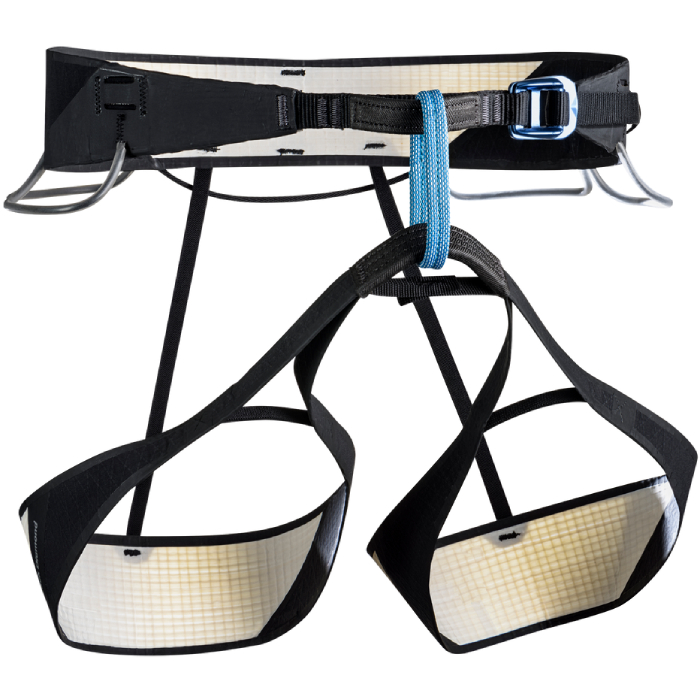Vision
Description
Built to trim every possible gram for ultralight performance on technical alpine routes, the Vision is the lightest fully functional harness we've ever made. Designed to satisfy the needs of the most discerning ounce-counters, the Black Diamond Vision Harness is a full-featured ultralight harness built for pushing the limits in the high, cold and loose. Clocking in at less than 250 grams, the Vision’s incredibly packable and quick-drying shell-less design is stripped to the core to provide gram-counting alpinists everything essential and nothing superfluous. Four pressure-molded gear loops, a rear fifth loop and four Ice Clipper slots accommodate a full alpine rack, and the speed waistbelt buckle makes for quick, simple and secure on/off.
Retail price
This Product is Hard to Find.
We don’t know where you can buy this item online in the US. We’ll continue to check all the major retailers and will update this page as soon as we find one.
If you know where to find this online in the US, let us know, and we’ll add the link.

Weight (g)  WeightIn grams, the weight, as stated by the manufacturer/brand. If there are differences in weight (due to multiple sizes or optional accessories) we'll list them here. The default weight is the middle-most size, often this is size M. | 224 g Black Diamond doesn't provide the weights for other sizes so we're working on gathering this info by hand, stay tuned! |
| Fit | Unisex |
| Sizes | XS, S, M, L, XL, XXL |
Gear Loops  Number of Gear LoopsGear loops are used to hold gear (quickdraws, cams, etc) onto your harness. 4 gear loops is most common. 
0 - 1 Gear LoopsMost often on full body harnesses or guide/gym style harnesses. 2-3 Gear LoopsMostly found on lighter harnesses made for [ski] mountaineering or high-end sport climbing where weight is a high priority. 4 - 5 Gear LoopsThe standard/most common number for climbing harnesses. Perfect for sport and trad. More Than 6 Gear LoopsDesigned for long multi-pitch and big wall climbing, found on harnesses made to hold the maximum amount of gear. Worth ConsideringOccasionally, the number of gear loops will change on a harness model depending on the size. There could be 7 gear loops for the med/large but only 5 gear loops for the xsmall/small. In this case we list the highest number for the filters, and then write an explanation on the product page like, “Size S/XS can only fit 5 gear loops.” | 5 Gear loops |
Ice Clip Slots  Ice Clip SlotIce clipper slots are made to fit a carabiner that holds ice screws. These slots are generally only used by ice climbers but there is no disadvantage to having them on your harness. 
Less than 40% of harnesses will have ice clipper slots. And those harnesses will usually have 2 or 4 slots, often located next to, or between, the gear loops. | Yes, 4 |
| Belay / Tie-In | One Loop |
| Waist Buckle Type | Quick Adjust |
| Leg Buckle Type | None (it stretches) |
| Drop Seat | No |
Haul Loop  Haul LoopTrad climbers often look for a haul loop as they're intended to haul a rope (second line) or pack (while you climb the chimney). 
A haul loop can also hold shoes or other accessories. Although not the intended use, it is also commonly used to hold a chalk bag. | No |
| Certification | |
| Size Chart | S (will fit the upper range of XS) |
No reviews yet.
The Vision has its limitations, though. It certainly shines for casual cragging and can work well for longer routes, depending on how light you're willing to go or if you supplement it with a gear sling and/or backpack. At some point, you'll probably want something a little more substantial. I won't be using this for any big walls, but it's a great option to have for that Grade III 5.9 with a two-hour approach.
How to use Carabiners and Quickdraws, warnings, inspection, care and maintenence with instructional pictures.
A pictoral representation of UIAA-105 and EN-12277 standards for harnesses.
The UIAA equipment standard provides a baseline for equipment performance in a test lab under controlled conditions on new equipment. Although these test conditions are relevant to the conditions encountered climbing, conditions encountered at the crags and the condition of the equipment are equally important. This recommendation from the UIAA member federation The British Mountaineering Council (BMC) provides vital equipment information that is NOT explicitly addressed in the standard, particularly failure modes of the equipment and recommendations for the use, inspection, maintenance, and retirement of equipment.














